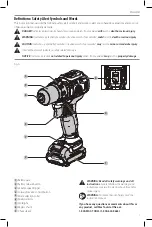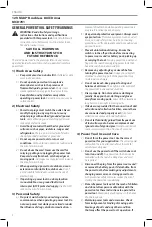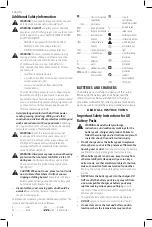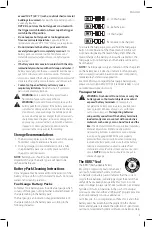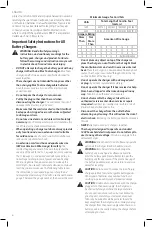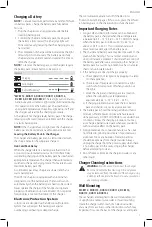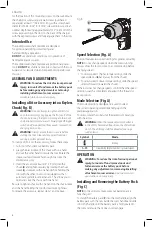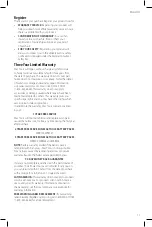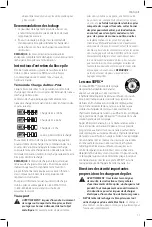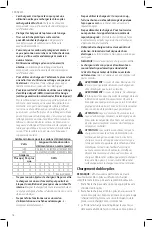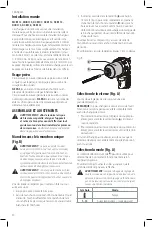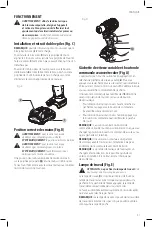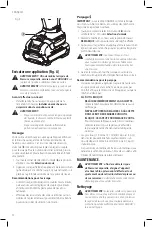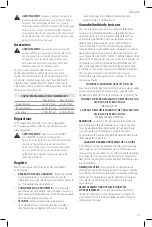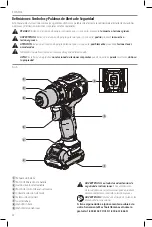
English
10
Repairs
The charger and battery pack are not serviceable. There are
no serviceable parts inside the charger or battery pack.
WARNING:
To assure product SAFETY and
RELIABILITY, repairs, maintenance and adjustment
(including brush inspection and replacement, when
applicable) should be performed by a Mac Tools
factory service center or a Mac Tools authorized
service center. Always use identical replacement parts.
MAXiMUM RECOMMEnDED CAPACiTiEs
Low Range (1)
High Range (2)
Metal drilling
1/4" (6.35 mm)
1/8" (3.2 mm)
Wood, flat boring
3/4" (19 mm)
1/2" (12.7 mm)
Hole saws
3/4" (19 mm)
5/8" (15.9 mm)
Accessories
WARNING:
Since accessories, other than those
offered by Mac Tools,
have not been tested with this
product, use of such accessories with this tool could be
hazardous. To reduce the risk of injury, only Mac Tools
recommended accessories should be used with
this product.
Recommended accessories for use with your tool are
available at extra cost from your local dealer or authorized
service center. If you need assistance in locating any
accessory, please .
Cleaning
WARNING:
Blow dirt and dust out of all air vents with
clean, dry air at least once a week. To minimize the risk
of eye injury, always wear ANSI Z87.1 approved eye
protection when performing this procedure.
WARNING:
Never use solvents or other harsh
chemicals for cleaning the non-metallic parts of
the tool. These chemicals may weaken the plastic
materials used in these parts. Use a cloth dampened
only with water and mild soap. Never let any liquid
get inside the tool; never immerse any part of the tool
into a liquid.
MAINTENANCE
WARNING: To reduce the risk of serious personal
injury, turn unit off and remove loads and
fastenersremove the battery pack before
making any adjustments or removing/installing
attachments or accessories.
An accidental start-
upactuation can cause injury.
Screwdriving
Your tool has a clutch with adjustable torque for driving
and removing a wide array of fastener shapes and sizes. The
numbers 1–15 on the mode selection collar
5
are used to
set a torque range for screwdriving. The higher the number
on the collar, the higher the torque and the larger the
fastener which can be driven.
1. Turn the mode selection collar
5
to the
desired position. Refer to
Mode Selection
.
2. Pull the trigger switch applying pressure in a straight
line with the bit until the fastener is seated at the
desired depth in the workpiece.
Recommendations for screwdriving
• Start with lower torque settings, then advance to higher
torque settings to avoid damage to the workpiece
or fastener.
• Make some practice runs in scrap or on unseen areas of
the workpiece to determine the proper position of the
mode selection collar.
Drilling
iMPORTAnT:
For MASONRY, such as brick, cement, cinder
block, etc., use carbide-tipped masonry bits.
1. Turn the mode selection collar
5
to the drill symbol.
Refer to
Mode Selection
.
2. Place drill bit in contact with the workpiece.
nOTE:
Use sharp drill bit only.
3. Pull the trigger switch applying pressure in a straight
line with the bit until it reaches the desired depth.
WARNING:
Tool may stall if overloaded causing a
sudden twist. Always expect the stall. Grip the tool
firmly to control the twisting action and avoid injury.
4. Keep the motor running when pulling the bit back out
of a drilled hole to prevent jamming.
Recommendations for Drilling
• When drilling, always apply pressure in a straight line
with the bit, but do not push hard enough to stall the
motor or deflect the bit.
•
iF ThE TOOl sTAlls:
-
RElEAsE TRiggER sWiTCh
iMMEDiATElY
,
remove drill bit from work, and determine cause
of stalling.
-
DO nOT DEPREss TRiggER sWiTCh On AnD
OFF in An ATTEMPT TO sTART A sTAllED
TOOl—This CAn DAMAgE ThE TOOl.
-
To minimize stalling or breaking through the
material, reduce pressure on drill and ease the bit
through the last fractional part of the hole.
• Large holes (5/16" to 1/2" [7.9 mm to 12.7 mm]) in steel
can be made easier if a pilot hole (5/32" to 3/16" [4 mm
to 4.8 mm]) is drilled first.
• If drilling thin material or material that is prone to
splinter, use a wood “back-up” block to prevent damage
to the workpiece.



